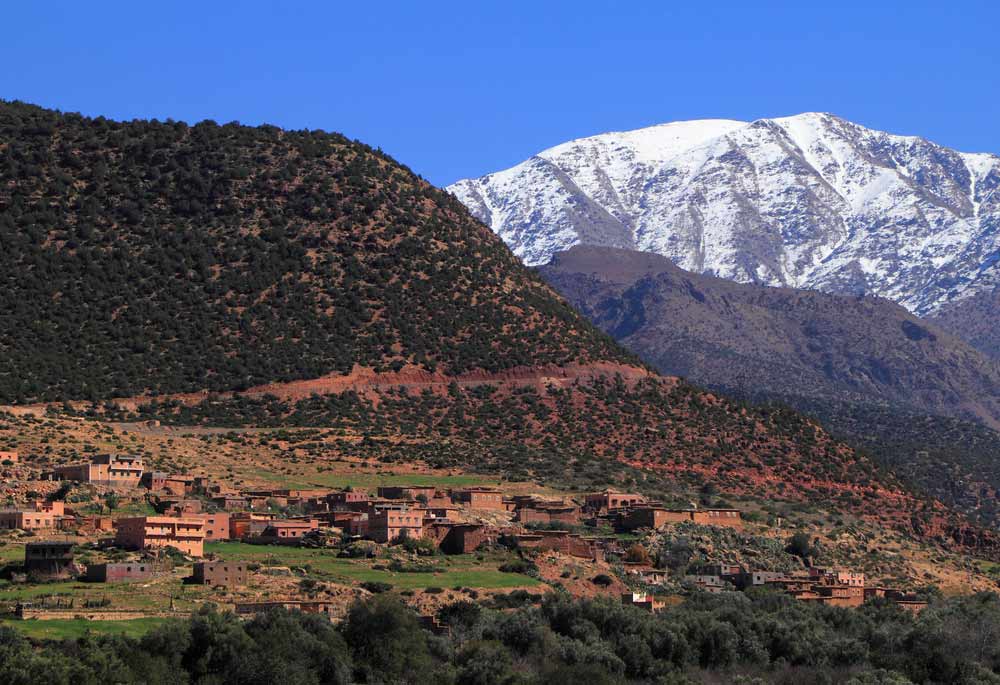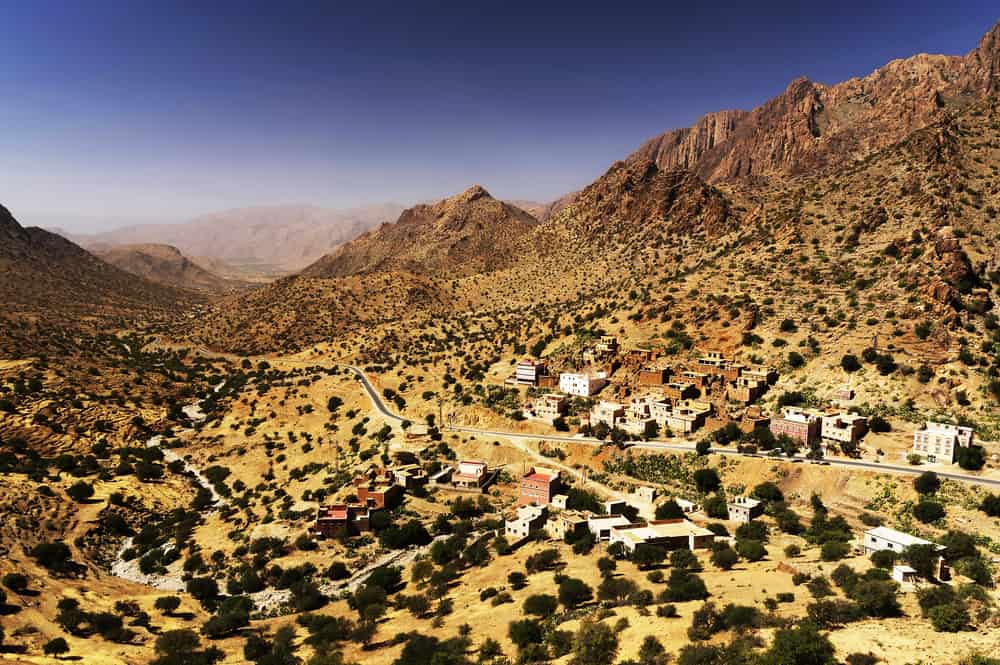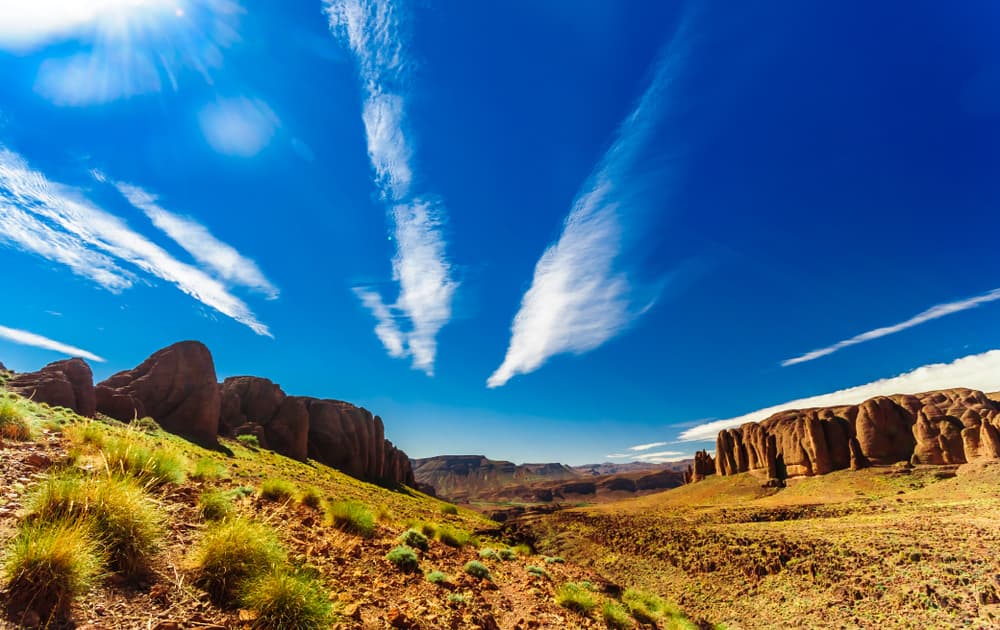Morocco is a land of stunning landscapes and rich history. Among its most fascinating features are its diverse mountain ranges. These mountains add to Morocco’s beauty and offer many adventures and cultural experiences.
The High Atlas Mountains are famous for their towering peaks and picturesque villages. They are perfect for trekking and exploring Berber culture. The Middle Atlas Mountains, known for their lush cedar forests, provide a cooler escape with beautiful scenery and wildlife. With their unique rock formations, the rugged Anti-Atlas Mountains attract adventurers seeking less-traveled paths. The green hills of the Rif Mountains offer breathtaking views and a rich mix of cultures. Finally, Jebel Saghro, a volcanic mountain range, presents dramatic landscapes and a taste of Berber traditions.
Each mountain range has something special to offer. Whether you are an avid hiker, a nature lover, or someone curious about different cultures, Morocco’s mountains have it all.
High Atlas Mountains

The High Atlas Mountains are North Africa’s tallest, stretching across Morocco and offering incredible views and thrilling adventures. These majestic mountains are home to numerous Berber villages where people live traditionally, providing a unique cultural experience.
The geography of the High Atlas is diverse. The range features snowy peaks, lush green valleys, and rocky cliffs. The climate changes with the seasons, creating a different experience depending on the time of year. In winter, the mountains are blanketed in snow, making them a popular destination for skiing and snowboarding. In the summer, the weather is warm and perfect for hiking and exploring the natural beauty.
Travelers can enjoy a variety of activities in the High Atlas. Numerous trekking routes cater to all levels, from easy walks to challenging climbs. The Toubkal National Park is a favorite spot, named after Jebel Toubkal, the highest peak in North Africa, standing at 4,167 meters. Climbing Jebel Toubkal is a must for adventure seekers. Besides trekking, the region is excellent for mountain biking, bird watching, and even rock climbing.
The Berber culture is a significant part of the High Atlas experience. Visitors can explore traditional villages, interact with the locals, and learn about Berber crafts such as weaving and pottery. Berber hospitality is renowned, and visitors are often welcomed into homes to share a meal or a cup of mint tea. Local dishes like tagine and couscous offer a delightful culinary experience.
The High Atlas Mountains combine natural beauty with cultural richness, making them a top destination for any traveler.
Middle Atlas Mountains
The Middle Atlas Mountains, located in the northern part of Morocco, are known for their cool climate and green, lush landscapes. This region is perfect for nature lovers and those seeking outdoor activities.
The geography of the Middle Atlas is unique, featuring lush cedar forests, serene lakes, and rolling hills. The climate is milder compared to other parts of Morocco, making it a refreshing escape during the hot summer months. Snow is common in the winter, especially around higher altitudes.
Visitors to the Middle Atlas can enjoy a variety of attractions. The cedar forests are home to the Barbary macaque, a type of monkey that delights visitors. These forests offer excellent hiking and picnicking opportunities. The town of Ifrane, often called “Little Switzerland,” stands out with its European-style architecture and beautifully manicured gardens. Ifrane is also a popular spot for winter sports, with skiing facilities available.
Dayet Aoua Lake is another highlight of the Middle Atlas. This tranquil lake is ideal for bird-watching, fishing, and boating. The area around the lake is perfect for hiking and enjoying the serene natural beauty.
Cultural insights in the Middle Atlas include visiting local markets where you can buy traditional crafts and produce. The Berber influence is strong here, too, with many opportunities to learn about the local way of life, including traditional music and dance.
Anti-Atlas Mountains

The Anti-Atlas Mountains are located in southern Morocco. Known for its rugged terrain and dramatic landscapes, this region is perfect for adventurers seeking a unique experience.
The geography of the Anti-Atlas is characterized by its rocky landscapes, deep valleys, and unique geological formations. The area is part of the larger Atlas Mountain range but is distinct in its arid environment and striking scenery. The climate here is dry and warm, making it ideal for exploring during the cooler months of the year.
Key highlights of the Anti-Atlas include the striking geological formations and hidden oases that dot the landscape. The region is known for its rich geological history, with many unusual rock formations and mineral deposits. Popular activities include hiking, rock climbing, and exploring the area’s many hidden gems.
One of the most famous spots in the Anti-Atlas is Tafraoute, a small town surrounded by pink granite rocks. Tafraoute is known for its vibrant local markets, traditional Berber crafts, and stunning natural beauty. The area is perfect for those who enjoy off-the-beaten-path adventures.
The cultural and historical significance of the Anti-Atlas includes visiting ancient kasbahs and Berber villages. The Berber people have a rich history and culture, which can be explored through their traditional crafts, music, and dance. Visitors can also learn about the area’s history through its many historical sites and landmarks.
Rif Mountains
The Rif Mountains, located in northern Morocco, offer a stunning landscape of green hills and a rich cultural mix. This region is perfect for those who love nature and cultural exploration.
The geography of the Rif Mountains is marked by rolling green hills, fertile valleys, and Mediterranean views. The climate here is mild and pleasant, making it a great destination year-round. The region receives more rainfall than other parts of Morocco, contributing to its lush greenery.
Major attractions in the Rif Mountains include the town of Chefchaouen, known as the “Blue City” for its blue-painted buildings. Chefchaouen is a popular spot for tourists, offering charming streets, vibrant markets, and a relaxed atmosphere. The Rif Mountains also offer numerous hiking trails with breathtaking views of the surrounding landscape and the Mediterranean Sea.
Cultural diversity in the Rif Mountains is evident in the blend of Arab, Berber, and Andalusian influences. Visitors can experience this rich cultural mix through the local cuisine, music, and festivals. The region is known for its traditional crafts, including weaving and pottery.
The Rif Mountains provide a perfect blend of natural beauty and cultural richness. Next, let’s explore the dramatic landscapes and Berber traditions of Jebel Saghro.
Jebel Saghro

Jebel Saghro is a volcanic mountain range in southeastern Morocco. Known for its dramatic landscapes and Berber traditions, this region offers a unique experience for travelers.
The geography of Jebel Saghro is characterized by its volcanic origin, resulting in dramatic rock formations and a desert-like terrain. The area is less visited compared to other mountain ranges in Morocco, making it an ideal destination for those seeking solitude and adventure. The climate is dry and warm, with cooler temperatures in the higher elevations.
Trekking and exploration are popular activities in Jebel Saghro. The region is known for its challenging hiking trails, which offer stunning views of the rugged landscape. The best time to visit is during the cooler months, from October to April. Popular routes include the trek from N’Kob to Boumalne Dades, which takes you through remote villages and dramatic scenery.
Cultural significance in Jebel Saghro is tied to the Berber people who inhabit the region. Visitors can learn about Berber traditions, including their unique architecture, music, and crafts. The Berbers in Jebel Saghro are known for their hospitality, often welcoming travelers into their homes.
Conclusion
Morocco’s mountain regions are a treasure trove of natural beauty and cultural richness. The High Atlas Mountains offer thrilling adventures and a deep dive into Berber culture. The Middle Atlas provides a cool, green escape with unique wildlife and charming towns. The Anti-Atlas is perfect for those seeking rugged terrain and hidden gems. The Rif Mountains blend stunning landscapes with a rich cultural mix. Jebel Saghro offers dramatic landscapes and a taste of Berber traditions.
Each region has its unique charm, making Morocco’s mountains a must-visit for any traveler. Whether you’re looking for adventure, nature, or cultural experiences, Morocco’s mountain regions have something for everyone. So pack your bags and get ready to explore the wonders of Morocco’s mountains.
